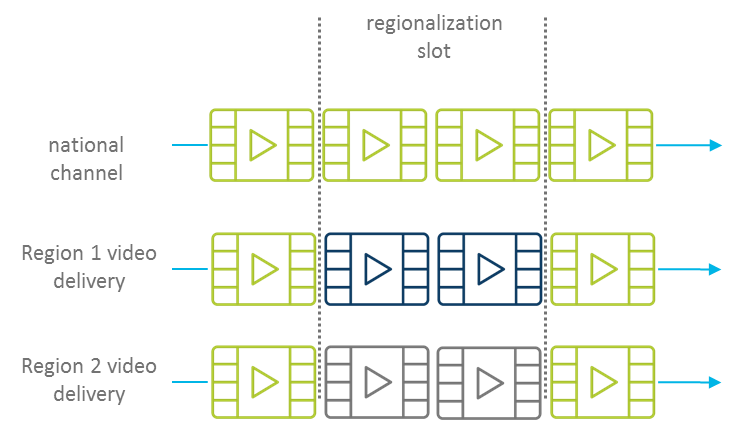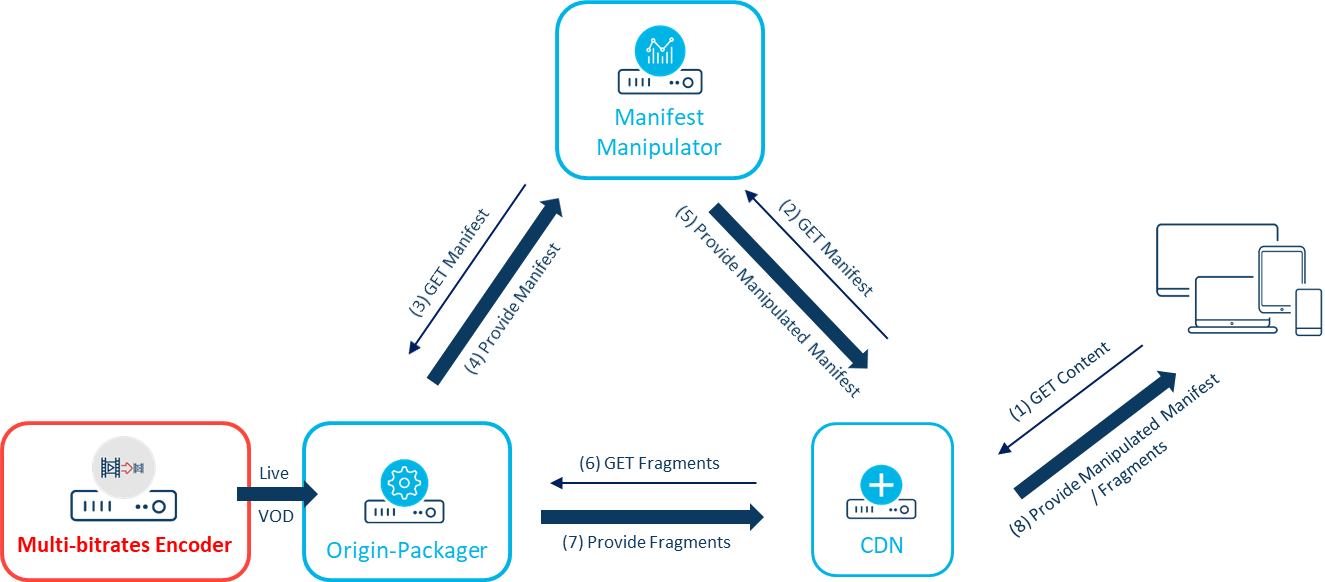Spanish version available here and Portuguese version here
Most cable operators in North and South America typically deliver regional versions of national channels, where sports (Regional Sports Networks) and news vary by market. This system is known as “linear parity,” and it concerns usually two-to-four minute video ad opportunities per hour.
This system of local video ad sales is a critical mechanism to generate advertising revenues for services providers. An article from Multichannel News, based on this study, predicts “that all local linear TV and digital video combined platforms will grow from $31.9 billion in 2017 to $37.3 billion by 2021.”
As the video delivery technologies continue to evolve with consumers habits, understanding and preserving linear parity,
In this blog post, I’ll explain its technical aspects and challenges and will discuss the benefits of using manifest manipulation to achieve it.
So, what are the technical specifics behind linear parity?
The concept will ring a bell to any of you running your linear programming in several locations. National linear channels have fragments defined as opportunities where regional content can be replaced depending on the local area.
Typically, legacy cable networks managed this system by creating all the variants of the different channels in the headend sites. This approach is costly in terms of hardware and support (i.e., regional ad splicing, encoding, computing, storage, square feet and power) and complex to implement. After deployment, with all the agreements in place and the ad revenues well-established, the platform usually remains untouched.
Nevertheless, with the pressure of moving to IP, this architecture needs to be reviewed. How can cable networks make it cost-effective without altering the lineup already in place?
Manifest manipulation can enable regionalization
As discussed in a previous blog post where the technical solution to deal with Sim-Sub (Simultaneous Substitution, a Canadian requirement to replace some content coming from the USA) was detailed, migrating to IP is a rare opportunity to add manifest manipulation. This module, which fits well in an environment used to deliver HTTP video (HLS for iOS devices, DASH for any other screens), allows networks to personalize video content per region, per channel, per device, or per user, in terms of both content and quality level.
Below is a basic view of a typical IP video data plane architecture:
In the case of regionalization, the idea is to deliver a manifest per channel/region combo. Each version of the manifest will include references to the right regional ads/contents and regular national content. The insertion is done based on SCTE35 markers, which are located inside national feeds. These markers are translated into placement opportunities by the Origin-Packager and inserted inside the HLS and the DASH manifests.
The CDN then retrieves the correct manifest based on the end-user location. If a customer is based in region A for channel X, the CDN will get the manifest for that particular combo. Based on what is inside the manifest, the player will then request the corresponding fragments with the ads for region A.
In short, networks can replicate the legacy behavior of introducing localized adverts, while allowing to keep the same relationship with (local) advertisers.
What are the immediate benefits of manifest manipulation?
As you may have already guessed, the savings created by the solution are clearly significant in comparison with the legacy architecture:
- There is no need to encode each regional channel or to use heavy hardware in each market. Everything is managed by one unique module: the manifest manipulator.
- On top of that, when you add services such as catch-up TV or Network PVR, you can optimize storage as well, and store only the necessary fragments. You no longer need to record two regional channels when you really only need to record one national channel and keep a few local advertisements on top.
- Finally, the location of the end-users was previously significantly limited by the market. With this new approach, you can introduce smaller regional zones versus the legacy satellite-based approach. It enables more accurate geo-targeting, which is definitely valuable, especially during election seasons.
How to handle legacy STBs
One of the first questions after fixing the migration issue is how to avoid the double ad platform silos. The legacy platform is still there, feeding the UDP type of legacy STB, but it is redundant — generating costs and requiring resources that could be used to focus on new technology.
Similarly, the advertising sales front is inefficient. Without a unified multiscreen approach to sell ads, the operators are missing opportunities to grow their video ad revenue.
Our recommendation is to convert the feeds post-packaging and post-manifest manipulation. In order to do so, you need an edge gateway capable of converting HLS and/or DASH to MPEG-2/MPEG-4 TS UDP. That will help replace the legacy feeds and ultimately get rid of the original platform.
By using this approach, you will be able to operate one distribution platform — opening up more opportunities for ad sales, better reach for programmers, and a smoother experience for the end-customers.
Leverage this new architecture to launch targeted advertising
As part of the strategy to migrate to IP, it is obvious that cable operators have targeted advertisements in mind. And when you take into account that Hulu is making more revenue via its ad sales than paying users (based on finding explained this article) you can understand why!
By bringing manifest manipulation to the table with the IP migration, operators can now enable pure Adaptive Bitrate advertising, with all the benefits included. Targeted ads promise to be a dream come true for programmers, and increase revenues to carriers. Using DAI (dynamic ad insertion) and programmatic ads, you can deliver the following functionality:
- Segmentation of viewing groups
- More relevant content
- Branded content delivery
- Customer targeting on any screen they use
- Improved agility to schedule and insert ads
- Capacity to interact with several marketplaces and ad decision servers
How can Broadpeak help?
Of course, Broadpeak is an experienced partner for your migration to IP, as explained in previous blog posts. This is based on our expertise across the video data plane. Our modules of origin, packaging, recording, streaming, management, monitoring and analytics will help you in your journey.
What’s more, Broadpeak has developed a particular expertise around manifest manipulation via our product BkYou exemplified by what we have achieved with Partner Communications in Israel to whom we provide:
- Ad tracking leveraging our Smart Library, APK installed in the customer application
- Ad skipping that we can personalize or simply disable
- Personalization by managing unlimited criteria to trigger the choice of the ad
- Ad decision server routing, enabled by talking with several ones in parallel and multiplying marketplace access
The BkYou Manifest Manipulator is now used for DAI, but also for any deployments where manifest adaptation is necessary. Blackout, simultaneous substitution or EAS are good examples of use cases benefiting from BkYou.
We can also help with the gateway in charge of HTTP to UDP translation. Our experience in multicast ABR where we need to convert unicast HLS/Dash feeds to multicast is obviously useful here too.
At the end of the day, is scaling the most challenging part?
Talking about multicast ABR made you think about scaling right? It’s a very valid question. The short answer is yes. Because of HTTP, scalability is key when you use ABR video delivery, and it is even more true in the case of DAI. Dealing with several thousand manifest requests per second is not an easy task, and having experience in streaming delivery like we do is definitely beneficial.
To answer this question, Broadpeak brings two key technologies to the table:
- A fully virtualizable/containerizable manifest manipulator BkYou, which has been designed as a micro-service that you can even host on other Broadpeak modules. By working in a cluster mode, it can scale elastically based on traffic.
- And of course, nanoCDN, our multicast ABR solution, which helps to scale live Adaptive bitrate streaming.
Both can be deployed co-jointly. You can, for example, use multicast ABR in the local markets to deliver regional channels created with a manifest manipulator deployed in a private cloud in the head-end. And it will be ready to scale when targeted ad insertion is enabled.
To conclude, what are the takeaways?
Our solutions can help you to achieve four main goals:
- When one of your subscribers moves from QAM to IP, thanks to our manifest manipulation per channel, they will see the exact same ad as the QAM version so you will have no loss of CPM in transition. We realize how important it is to keep the local ad sales business intact.
- We will help unify the infrastructure and get rid of all old splicing devices and ad servers in the network. This is achieved through a gateway that inputs ABR and outputs linear SPTS to a QAM.
- We will help prepare you for the next generation of targeted ads by providing you a manifest manipulator that can support several ad decision servers in parallel. This will multiply your presence over different marketplaces in parallel and will increase your visibility and revenue.
- We will deploy a solution that scales, using virtualization and multicasting wherever it is possible. We know DAI and personalization will generate a surge of manifest requests. We will use our experience, based on hundreds of CDN deployments, to ensure the platform is able to cope with the rise of traffic.
Let us know if we can help you with your ad insertion or IP migration project. We will be happy to share our experience and boost your ad sales!



